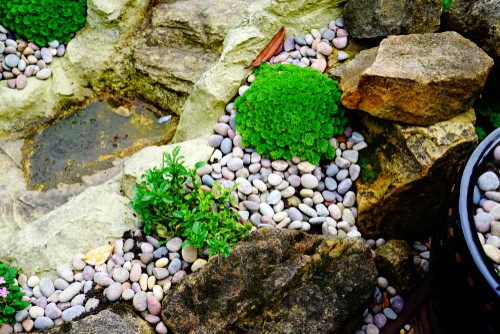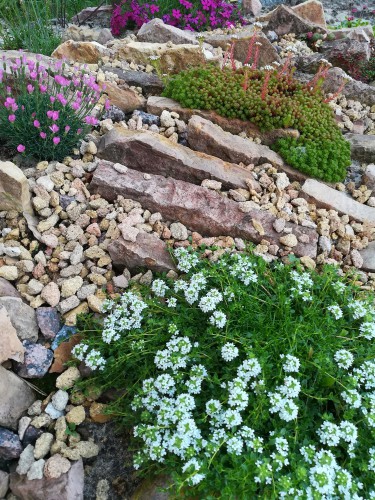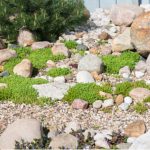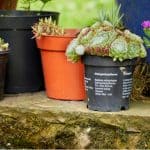Last updated on May 25th, 2022
Our site is reader supported, this means we may earn a small commission from Amazon and other affiliates when you buy through links on our site.
Alpine rockery plants originate from high altitude climates, above the treeline where they have access to ample sun, but also a lot of exposure to cold, winter weather. That is why they do so well in UK rockery gardens and tolerate the winter conditions but they do need well-drained soil with plenty of grit mixed in.
If you plan to grow and care for alpine rockery plants though, you still need to enforce some measures to make their growing habitat suitable.
Learn how to make a rockery using our detailed guide here
Planting Alpine Rockery Gardens
How to plant them.
Drainage is very important. Again, being plants that live above the tree line in high-altitude locations, they get ample drainage down the mountains and hills where they grow. You need to ensure that drainage is recreated at home. They will tolerate cold weather just fine, but not wet feet.

I have also posted a guide show you how to create an alpine rockery planter here
Types of rockery stones
Limestone is the traditional rockery stone, but it is hard to find today. That being said, sandstone is widely available.
Choosing the right compost for rockery plants
Fill in any gaps between your rocks with a loam/grit compost mixture, we recommend using a mixture of John Innes potting compost mixed with about 30% horticultural grit. This will ensure the soil they are planted in is well-draining but will still retain moisture.
Plant in full sun and consider planting in containers in the ground
Find areas in the rockery where access to the sun is possible and good drainage is offered. One way to help with drainage is to plant your alpines in different containers and then bury the containers in your rockery. This will prove useful for those who want to grow a multitude of alpines that prefer slightly different soil conditions (like alkaline or acidic) so that each can have its preferred environment in the container. Add extra drainage holes to the bottom, and maybe even a layer of grit or gravel if you go down this route.
Add a layer of stone or grit on the surface of the soil, as pictured below.
Put a layer of decorative grit around the plants to stop soil from splashing up when it rains, this also helps keep the soil cool and retain moisture. Moreover, the decorative grit will help keep away the snails and slugs at bay.
See our top 10 recommended rockery plants for beginners

Regular Care
Watering
Once they are planted, you have to maintain them. Start by watering them right after planting. They won’t likely need a lot of watering unless the weather is particularly warm (which is kind of a rarity in the UK) although we do sometimes get some warm months if we are lucky.
Feed with a high in potash feed in spring
At the start of spring, give them a high potash fertiliser to encourage more flowers. Once the alpines start to flower, deadhead them to keep the flower production going.
Trimming alpines
Many of the alpines can be trimmed once they have finished flowering, to keep them in control.
Problems to keep an eye on
As you care for the new plants, be on the lookout for problems. Some alpines might outgrow their space if they are fed too often or if their soil is too rich. Others might succumb to root rot if they remain too wet or have poor drainage.
You should spray an insecticide at the preliminary signs of pests. Slugs and snails will be your biggest issue and they can be deterred with horticultural grit around the plants and by using slug traps.

Pay Attention to Variety
There are many varieties to have in an alpine rockery and they influence the aftercare requirements. Succulents, for example, are low maintenance and once planted need almost nothing from you except for protection against severe frost in more open sites.
In general, most varieties will grow just fine with little help, which is what makes them so popular.
Thymes make wonderful space fillers, between the rocks and around the other alpine plants, plus they give off a delicious aroma too.
Best selling rockery plants
- 20 Different Alpine Rockery Plants in 9cm POTS ~ Quality Alpines Direct from Specialist Grower in West Pinchbeck, Lincolnshire
- You will receive 20 DIFFERENT Alpine Plants in 9cm Pots - Carefully selected by us to provide a good mix of foliage and flowers from early Spring to Autumn.
- Photos show examples of previously despatched Alpine Collections at various times of the year. As growers, we supply spring, summer, autumn and winter. All sent with The Alpine and Grass Nursery's Plant Passport.
- Our family have been growing alpines for over 35 years, first in North Yorkshire and now in Lincolnshire. Beautiful rockery plants sent fresh to your door from us, the grower. Add a Greeting to the box for Free, Eg Happy Birthday Dad!
- Pot Size: 9cm.
- Supplied Height (Inc. Pot): 20–30cm.
- Characteristics: The selection of perennials have evergreen foliage and are extremely hardy plants.
- Flourishing Season: Colourful flowering through the Summer months, mid-May to mid-September.
- Water & Maintenance: The collection of plants require little water. Make sure to plant in retentive, well-drained soil in full sun. Drought tolerant over extended periods.
- HARDY ALPINE PERENNIALS - This Alpine mixed 6 pack features a carefully chosen selection of hardy perennials for UK gardens, including Leucanthemum, Phlox douglasii 'Eva', Campanula garganica 'Major', Armeria 'Abbey Deep Rose', Sagina subulata var. glabrata, and Helianthemum 'Ben Ledi'.
- LONG LASTING SEASONAL COLOUR - Enjoy a colourful display from Spring into Summer with a mix of unique flower shapes and tones, from bold reds and purples to soft whites and pinks. A varied blend that adds texture and visual interest to any garden.
- IDEAL FOR ROCKERIES AND BORDERS - These compact alpine plants thrive in UK conditions and are perfect for gravel gardens, alpine beds, containers, and borders. Drought tolerant and low maintenance, they offer reliable colour with little effort.
- GREAT FOR POLLINATORS AND GROUND COVER - This alpine mix attracts bees, butterflies, and other pollinators while providing low, spreading ground cover. An attractive, wildlife friendly choice for edging paths or filling gaps in borders and rockeries.
- CARBETH PLANTS - We are a Scottish based company with over 20 years experience in horticulture. With a large variety of plants for the garden, indoors and also gift wrapped for special occasions. We pride ourselves on prompt delivery as well as our quality and affordable plants.
- Attractive all year round
- Low maintenance easy to look after
- Great in borders or as a focal point in a Tub or planter
- 6 Different heathers shrubs
- Buy From Meredith Nurseries.
- 40 DIFFERENT Alpine Plants in 9cm Pots - Carefully selected alpine collection with The Alpine and Grass Nursery's Plant Passport.
- Photo shows example of previously despatched Alpine Collection - ALL GROWN BY US AT THE ALPINE AND GRASS NURSERY ~ HARDY ROCKERY PLANTS FROM WEST PINCHBECK IN THE LINCOLNSHIRE FENS.
- Our family have been growing alpines for over 35 years, first in North Yorkshire and now in Lincolnshire. Beautiful rockery plants sent fresh to your door from us, the grower.
- Add a Greeting to the box for Free, Eg Love you Grandma and Grandpa! xx
Image credits – Shutterstock.com
Last update on 2025-07-15 / Affiliate links / Images from Amazon Product Advertising API







